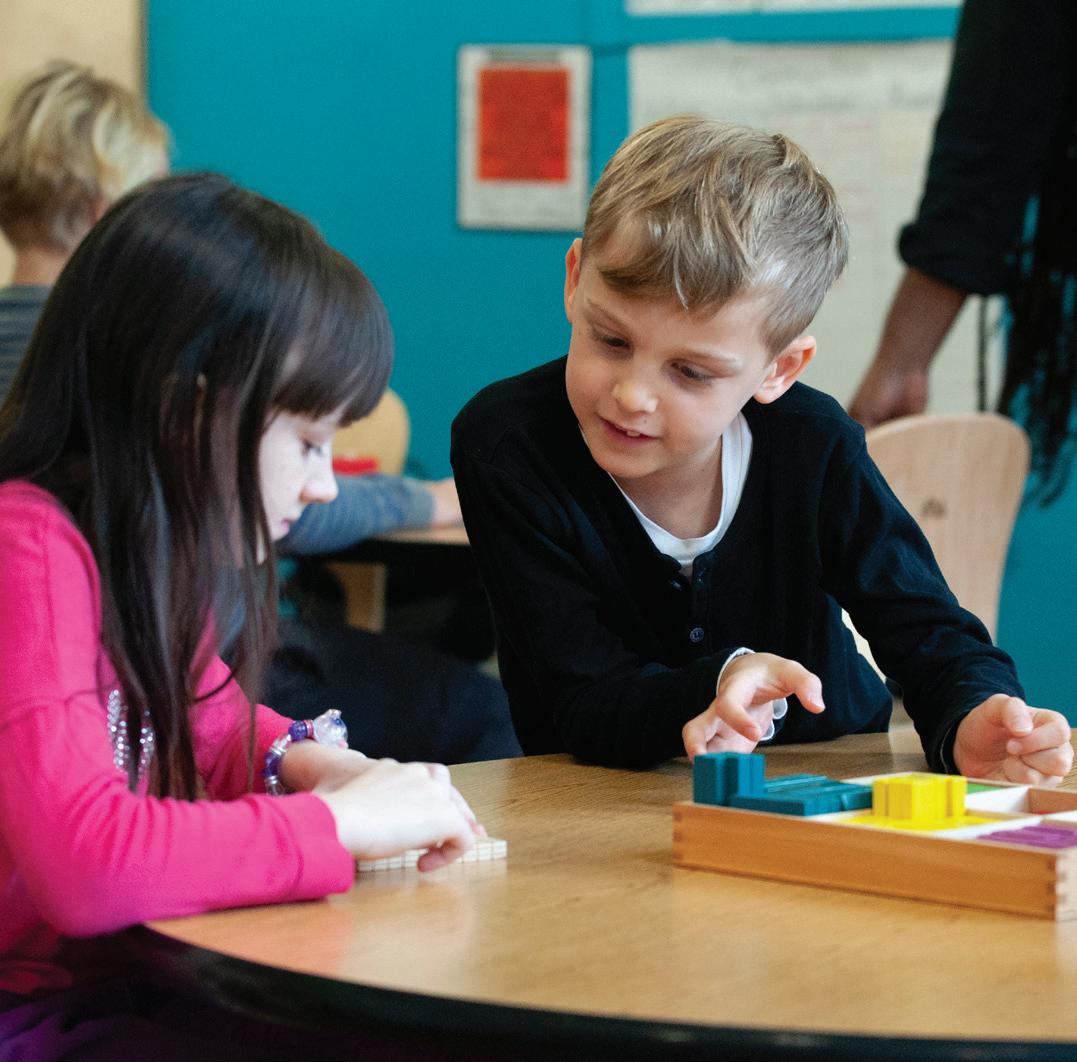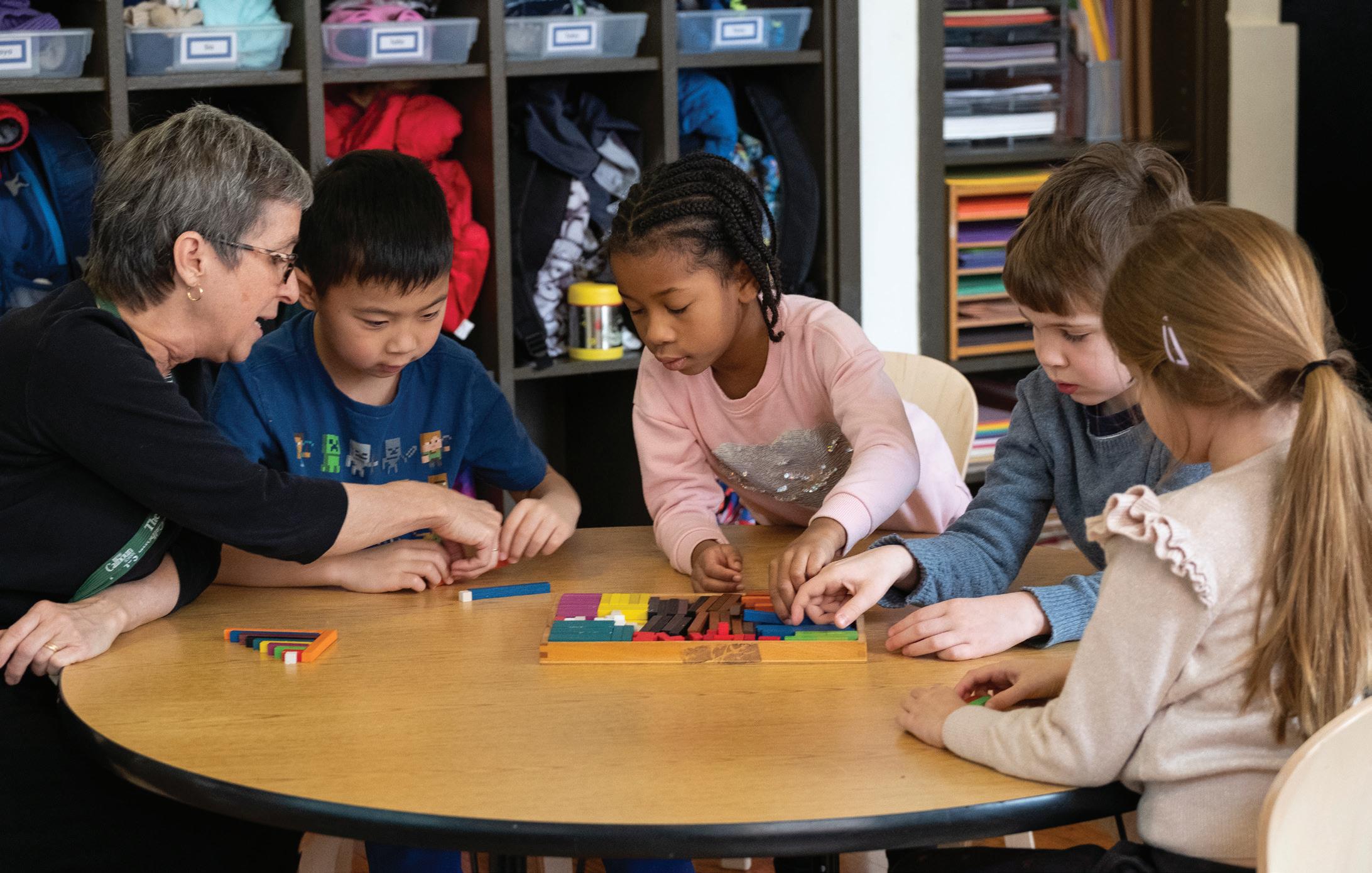
6 minute read
Childhood
2 0 FEATURE Making Mathematicians: Calhoun’s Approach to Math in Early Childhood Making Mathematicians: Calhoun’s Approach to Math in Early Childhood
by Michelle Kiefer by Michelle Kiefer
It’s a familiar scene in childhood: kids building a tower of blocks, carefully placing each one, until, through trial and error, their construction stands tall and secure. But there’s a lot happening below the surface of this common activity—more than mere child’s play, it’s actually the beginning of mathematical thinking and problem-solving. Through their everyday exploration, children naturally “mathematize” the world around them (studies show that even babies recognize number groupings), and it’s our job as educators to harness their natural inquisitiveness and lead them to greater discoveries.
This view of learning—in which children are actively constructing knowledge from their experiences —is known in ed-speak as “constructivism,” and it’s the framework Calhoun educators use to teach math in early childhood. Calhoun teachers focus on creating learning experiences that actively engage students and help them make important mental connections. Math teaching in our early-childhood classrooms isn’t restricted to worksheets; children investigate puzzles, ask a lot of questions and are given the space to come to their own “aha” moments. Research shows that this is the type of learning children hold on to for the rest of their lives.
“Math is an abstract language,” says Anthony Yacobellis, Lower School —Early Childhood Math Coordinator. “In order to make sense of that language, children need to have experiences behind the curtain.” The math curriculum in our early-childhood program is very hands-on, in order to give children concrete encounters with abstract ideas. For example, Lower School teachers frequently organize activities with Cuisenaire rods, colored bars that represent numbers, to illustrate concepts such as addition, subtraction or place value. Being able to touch, see and manipulate these types of objects provides children with a tangible frame of reference, an essential foundation for the higher-level math that is to come.
The way our youngest students learn math is akin to learning a foreign language by becoming immersed in a country, rather than just memorizing a list of vocabulary. We create lessons that put the language of math in context. First graders recently learned about the fictional “Masloppy Family,” who needed help organizing their house. The story inspired the students to take an inventory of the objects in their classroom. They quickly realized that counting by ones was an inefficient strategy, and so they started to bundle items in groups of five or ten. Through this hands-on activity, children explored concepts of place value and multiplication in a way that connected to their lives and was ultimately much more powerful than if a teacher had simply stood in front of the room and told them how to skip-count.
When math is put in context for kids, it becomes an important part of their worlds, and they start to feel a real


sense of ownership over the subject. When teachers find ways to put math into what children are already doing, children will do more math, have more fun doing it and begin to think of themselves as mathematicians. It’s no wonder, then, that Little Calhouners are unmistakably excited about doing math. “Everyone here feels like a mathematician,” observes Alison Rothschild ’85, Director of Lower School —Early Childhood.
Little Calhouners are also learning a very important aspect of what it means to be a mathematician —it’s not always easy. “Challenge is an important part of the early-childhood math experience,” says Alison. “We want students to learn to work through difficult problems and understand that being a mathematician means trying things multiple times until you find a solution.” Calhoun teachers deliberately lead kids outside of their comfort zones to help them build resilience and confidence as problem-solvers. We create an environment in which struggle and mistakes are normalized, combating the idea that only certain students are “math people,” and further diminishing math anxiety.
The most important way we create challenge for kids is by helping them delve deeper into the concepts they’re studying. We want children to be able to understand the “why” of math

beyond just the execution of a series of steps. “Kids might be able to mimic what you’re doing, but it doesn’t mean they understand the concept,” says Anthony. “Memorization is not learning; it’s regurgitation.” We continually challenge students to articulate why they know what they know, to think critically and to develop new and efficient strategies for tackling problems. This focus on articulation of understanding over the memorization of procedure helps kids gain a fundamental grasp of the relationships between numbers. They become agile mathematical thinkers who can apply their knowledge to unstructured or unfamiliar problems. They can even begin to invent things that haven’t been seen before.
When you talk to Calhoun teachers, they are full of stories about students making big discoveries in math: a third grader who figured out a quicker way to do three-digit subtraction, a fourth grader who found a new way to multiply by six. Calhoun students are embracing their identities as mathematicians, thanks to the foundation they’re receiving in early childhood. One teacher recalls that one of his students loves to exclaim, “I have a theory!” Indeed, Calhoun math classrooms are places where students can have theories and pursue them, so there’s ultimately no limit to what they can discover next.
MATH IN ACTION: CUISENAIRE RODS
Cuisenaire rods are one example of tools used by Calhoun teachers to help bring math to life for young learners. Each rod has a different color and length, turning abstract values into something that children can see and feel. Because of the tool’s effectiveness in helping students construct understanding, even college professors have been known to use Cuisenaire rods to illustrate advanced mathematical concepts. Here are a few examples of Cuisenaire rod activities from our early childhood classrooms.
Staircases (kindergarten, shown at top)
Children first build a staircase with five rods, each representing a value from one to five. Next, the teacher challenges them to continue their staircase up to ten steps, while only using rods one through five and without placing two of the same rods next to each other within a single step. The teacher might also ask students to construct each sequential step using one more rod than they used on the previous step (two numbers that come together to make six, three numbers that come together to make seven, etc.). Through this activity children practice addition while exploring the different ways numbers can be composed and decomposed.
Mystery Train (first grade, shown at middle)
The teacher provides a series of clues about a “train” (a horizontal line of Cuisenaire rods placed end to end) and challenges students to determine the value of the mystery train. A teacher might say, “One of my rods is two more than the other rod,” and children then build their own trains that fit the description. Through this activity, children practice addition and discover the various ways to make a number. It also promotes the idea that there can be multiple answers to a given problem. Students develop flexibility as problem-solvers through the process of continuously searching for viable solutions, looking for evidence and checking their work.
How Long, How Many? (second grade, shown at bottom)
In this game, students make four-sided, solid shapes with Cuisenaire rods and place them on a 10-by-10 grid until no more space is available. To play, children roll a die to determine which rods to take—the first roll determines what size rod, and the second roll determines how many of those rods. The activity can serve as an early introduction to multiplication as students observe the different ways to form rectangles. As they calculate the area of shapes, students are exploring the big ideas of equivalency and part/whole relationships. They also practice addition, subtraction and strategic thinking by keeping track of how many spaces are covered and how many remain on the board.





